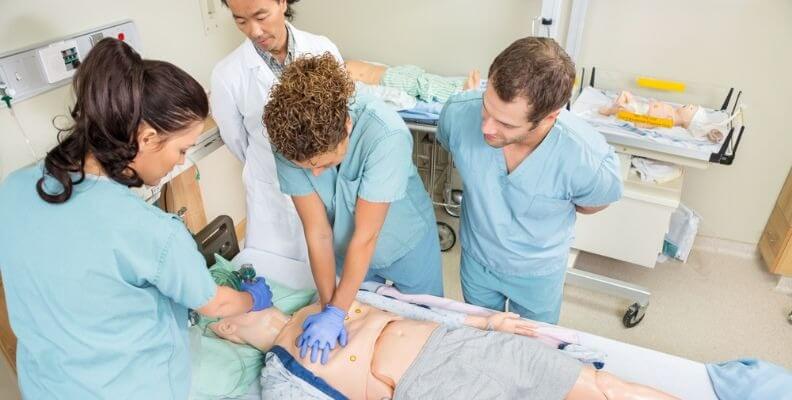Nursing Students’ Perspective: Surviving Simulation Lab
Written by Caitlin Kretschmar, Student Nurse
Caitlin Kretschmar is in her junior year of nursing school at the University of New Hampshire. In high school she planned to go into business after graduation, but she found her plans changed suddenly, when a ruptured arterio-venous malformation landed her in the Children’s Hospital of Boston for weeks. It was there, surrounded by amazing nurses, that she began to re-evaluate her plans. During her recovery, she realized that she truly wanted to be a nurse, and that everything happens for a reason. BestNursingDegree.com is grateful to Caitlin for sharing her story and perspectives on nursing school.
You are sitting outside the door, you can hear your heart beating in your ears, your palms are clammy and everything you have learned up to this point is now running through your head…
I.D. the patient, vital signs, pain assessment, and still, you never really know what to expect waiting outside the door of your simulation lab.
“What if the patient asks me about their diet?”
“What if they have chest pain?”
“What if they go into fluid overload?”
There are a never-ending amount of questions running through your head as you wait for the signal to go in. Standing there, with your partner and the tangible tension of anxiety in the air. Then… BAM! The light goes on, you take a deep breath, knock on the door and enter the room.

Simulation lab is used to teach nursing students in a hospital like environment.
It is an exact replica of a patient room, with two exceptions. First, the patient is a manikin, with programmable heartbeats, lung sounds, voices, pulses, etc. The other exception is that the window does not overlook the park or street; it is a two-way mirror.
There nursing instructors sitting behind that mirror in the control room, and they are watching your every move. They have cameras that can zoom in to see exactly how much Ativan (actually, sterile water labeled Ativan) you are drawing up in that syringe. Everything in the simulation lab is made up to be as realistic as possible. We use all the same supplies that are used in hospitals, excepting the medications, which are either sterile water, or candy for the pills.
Every nursing school is different when it comes to Simulation Lab aka “Sim Lab”. Some grade the students, some don’t. As for my school, we are graded “pass” or “non-pass” for every scenario. We are given the patient information a week in advance. We are then left to prepare for anything that may happen to that patient based off of that information. After we complete the simulation, we have a debriefing, where we go over what we did. By going over what we did, it allows us, as students, to realize the mistakes we made on our own.
When preparing for the scenario, I personally attend “open lab,” where we are allowed to go and practice the skills for that week. The skills range from putting in a foley catheter, to hanging blood. I ask questions, and make a guide to the scenario. The guide includes any orders, procedures, allergies, and other patient information necessary for the simulation. I use this guide as reference while in the simulation.
Although, Sim Lab produces more anxiety than walking into a real life patient’s room, it teaches in a way that lectures and power points do not.
You learn by experience… a safe experience. When you make a mistake in sim lab, the manikin’s vitals may bottom out, but no harm is done to a human being. You learn from your mistakes. In sim lab we learn the skills, we better our therapeutic communication, and critical thinking becomes a second nature. All in which are important traits of a nurse.
When it comes to simulation lab always remember, that it is not a real patient, and it is for learning purposes. And don’t forget after each simulation you are that much closer to becoming a real life nurse.
Caitlin Kretschmar is in her junior year of nursing school at the University of New Hampshire. In high school she planned to go into business after graduation, but she found her plans changed suddenly, when a ruptured arterio-venous malformation landed her in the Children’s Hospital of Boston for weeks. It was there, surrounded by amazing nurses, that she began to re-evaluate her plans. During her recovery, she realized that she truly wanted to be a nurse, and that everything happens for a reason. BestNursingDegree.com is grateful to Caitlin for sharing her story and perspectives on nursing school.




